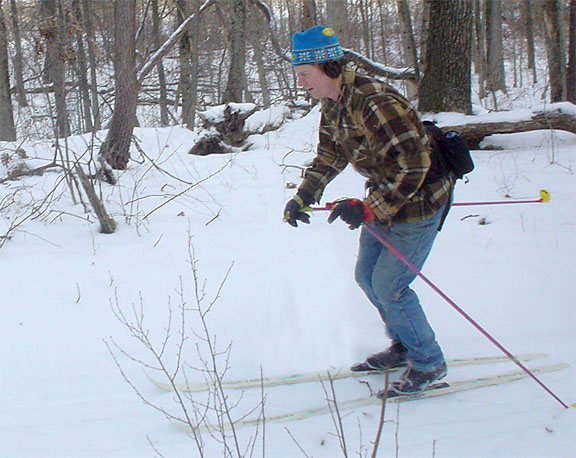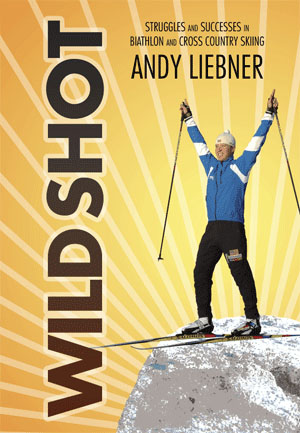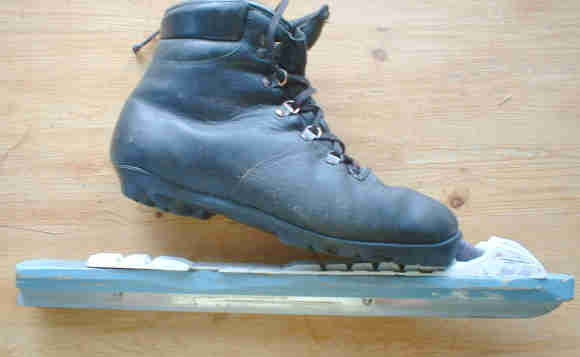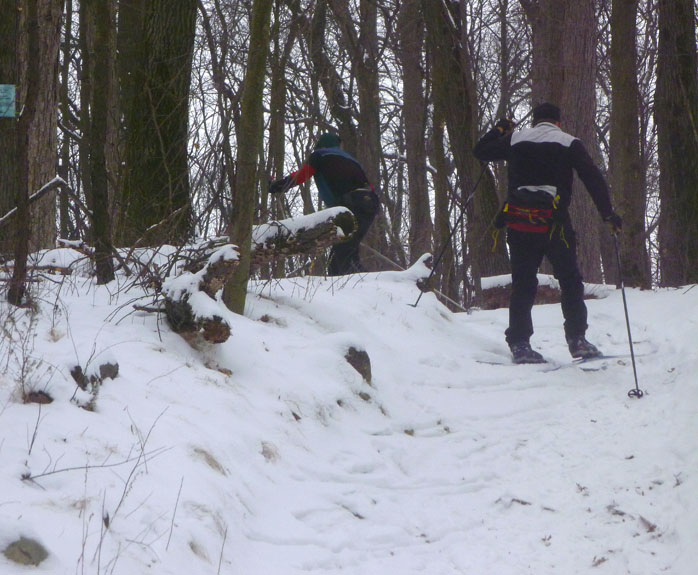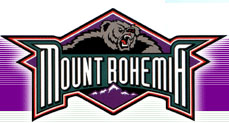[BUMP from 1/08] I just googled this subject and nothing much came up. I should look again but in the meantime since I’m such a buff of XC as being a super thing to do in the snowy winter I really should do all I can to help folks out here with doing the darn motion as effectively and pleasingly as possible.
In several other languages, including Scandi tongues, the XC ski moves are called “dances.” This is a good way to view XC: it’s a smooth, flowing, rhythm thing that gives you effortless-seeming glide as a result. And anyone can do it.
When I see adults (and kids) out skiing who think they know how to ski most of them aren’t really skiing, sad to say. I presume they taught themselves. Another weird thing is that they can’t imitate me when I show them what to do. And they clearly don’t know what they are actually doing because when I tell them to do something they always think they’re doing it, but they’re not. At all. So there’s a natural disconnect, as it were. I think this is why the top clinic teachers all use video-taping of students as part of a session. Ya gotta see what you look like to really know what you’re doing. And believe me, you may well be getting in your own way.
But the fix is easy!
OK, here’s what you’re doing, most times: you’re bent over at the waist, like your waist is a hinge of some kind. Your butt is sticking out back. Your legs are rather stiff and straight. Your arms are stretched out straight in front of you as you pole. You pole, then awhile later you kick. This method can actually work pretty good. But you’ll slip on the uphills and you’re working much harder than you have to. You’re straining your back.
Here’s the fix!
Throw away them there poles!
You won’t be needing them for awhile.
Find a flat straight area with good ski grooves. Longer is better. Now ski back and forth without the poles. Find a similar area with a bit of a slope. Now do it again. Do this for 15 minutes, say—until you’re enjoying it. That should do the trick! You’re cured! : )
Here’s what you learned when skiing without poles—to get kick and glide you had to swing your arms forcibly and with some snap back and forth IN TIME WITH your kicking. To get grip with your kick you learned that you had to kick all the way over from one ski to the other. It felt like ice-skating, only not going from side to side. You probably even started bending your arms at the elbows and swinging/twisting your trunk/torso. You stood up tall and shoved your hip forward to get glide and so you could stand up nice after the glide to get a good kick. You had nice core stability, as they say. And you dropped down a bit between each kick and armswing as your legs and arms passed each other—you flexed your ankles a good bit—this drop and flex let you “set” the ski and get grip.
You felt like …as Lucy says… CHAZ MICHAEL MICHAELS!!!!
…The star of the movie THAT SHALL NOT BE NAMED.
So go out there and be CHAZ!
Throw away those poles. They’re just crutches. …Until you get your timing right, that is. No, they’re not crutches—they actually mess you up. You should indeed start poling before you kick, but only for a moment. Basically the two things happen at the same time. The poling propels you but it also helps you move from ski to ski. One kick is also meant mostly just to help you get over to the other ski. You’re just doing a couple simple moves to help you move from ski to ski. That’s skiing! The glide comes in naturally.
Our wee Lucy, age 7, is not very sportsy and has a temper. But she enjoys the outdoors and is observant. She was a wobbly ski-walker with a short fuse (inclined to throw ski equipment at the slightest sense of awkwardness despite doing fine). She turned into a dancing, well-timed, actual SMILING skier in ONE 15 MINUTE SESSION of Being Chaz!!!
Glory be! And thank you, Heavens Above, that it worked!!!
***
Now here’s another tip, from someone else. I haven’t verified that it works but it may well. It’s worth a try. Maybe you can even use your poles—he didn’t say. Go jogging down the trail on your skis. Don’t slide them forward, lift them up. This should help you with the idea of weight transfer and what it takes to “set” the ski so that it grips. A ski has camber, an arc, so that the middle of the ski rides off of the snow when both skis are equally weighted—you have to put ALL of your weight onto a ski to get it to grip at its best. Once you get a feel for what it takes to get it to grip you can stop the lifting and the jogging and get back into the swinging. But you’ll still have to change your weight ALL the way over from ski to ski in kind of a pounce to get them to grip. But it’s not that much of a pounce—it’s really just changing where you’re standing from foot to foot—like when ice-skating and only one foot is gliding on the ice. When you completely transfer your weight IS WHEN BALANCING IS EASY! You wobble only when you do it halfway. If you completely transfer your weight you’ll find that you just stand up on each ski nicely. Skis are made to balance. Let your skis, boots and bindings do what they’re made to do.
Ideally you should get a lesson to learn how to ski. But my tips here should work well enough.
Ideally you should use a newstyle boot and binding. NNN or Pilot-Salomon. Not 3-pin or old Salomon “beak loop.” The new midlength skis are probably great to learn on. Lots of folks like them in general. My pro shop and ski media dude pals say they’re sweet. Not as much glide but easy to handle. I tend to bulge my eyes and explode at that kind of heresy: GLIDE is the whole reason for the game! Without glide you’re left with WORK. Skis handle just dandy as they are. Like snowshoes—the back follows the front. It’s not rocket science. Forget about the turns and the downhills. They’ll come easy and crashing is soft. They’re not what you need to learn. You can walk and run so you can stay on your feet and figure that stuff out. Step or skid around a corner and you’re done. It’s the timing, the weight transfer, the rhythm and the glide that we need to get you grooving on. Skiing every day for a few minutes without poles is a great way to get that into your head!
Yeah, it might take awhile for the lesson to sink in. Hopefully your fave trail starts out easy. You can bring your poles with you—just don’t put em on—hold em by the middle—get your swing timing and bounce down first. Then put the poles on.
Oh, do you want to know how to use the poles? Answer: use them all the way! Be sure to push all the way thru, to the back, til they don’t work anymore and they come out of the snow with a flip and you’re gliding on the other ski. They’re working the most for you as they come by your side. They’re working THE LEAST when they’re out in front of you. Plant them near your feet, not out in front. You want them angled to the back—so when you push down and back on them you go forward.
And here’s how to pole and kick so easy you won’t even notice it: tip forward. It’s a great drill. Stand up, now lean forward until you fall—then catch yourself with a foot out in front. Let your back foot tip up and off the ground. That’s all the kick you need to get a ski to grip and send you gliding down the trail. Let your body weight do it! When you’re skiing you tip forward then catch yourself with both your pole and your ski. Then you tip forward again and catch yourself with your other pole and ski. Get it? Just tipping forward gives most of the power you need to pole—now just push it down and away from you.
Try double-poling: no kick, 2 poles at once, on a slight downhill. To do it, stand up straight, hips forward, then let yourself fall forward and catch yourself with your poles. Boom! they’ll fly out behind you and you’re on your way.
Try a kick-doublepole. –Give a kick and throw yourself out there—catch yourself with both poles—they’ll really fly away out behind you. Swing your poles back forward and drop a bit and flex your ankle as you do—then kick again!
Now, how to glide easily UP a hill? I bring my pole-hands in closer to me a bit more when I plant them, more by the balls of my shoulders, rather than reaching out, that is, my arm is bent a lot. I swing my bent elbows forward. Also I use a lower position—I flex my ankle and knee more deeply. I still try to pole all the way through to the rear. But as the hill gets steeper one “chokes up” and becomes more compact—while still staying relaxed and trying not to work hard. This approach lets me get both grip and glide on moderate uphills. If I ever slip on an uphill—which I do fairly often—I just instantly drop down even more—that somehow lets my missed kick not be a totally lost cause and maybe it lets me have a better chance with the next foot.
Well, please let me know how this all works out for you… : )
